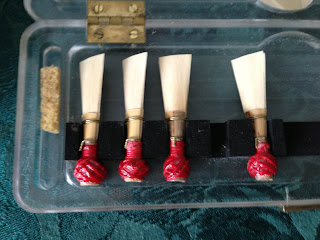I have a new reed making machine. It's called the "Ultimate Reed Finishing Machine". It works the same way a tip profiler does, only it processes the whole blade of the reed from collar to tip.
My machine is made by the German company, Rimpl, although there are other firms that make a similar machine. I purchased it from Miller Marketing. The machine I ordered came with a template and tongue custom designed to my specifications. I sent them three finished reeds to use in copying my scrape to the template and fitting the tongue to my reed shape and contour.
With customizing the price is about $200 more than that listed on Miller's website ($1799). This makes this machine very expensive. However, a Rieger tip profiler is about the same cost and it only processes the tip of the reed.
In a previous post I registered a strong opinion about expensive profilers. However, I'm very convinced that this machine is worth the extra money. I'll explain why in a minute, but first watch this demo I made. (Warning, I have no future as a videographer! Keep the volume control handy. Some of the clips are recorded at a lower level than others.)
A Demo
Here is a demo I made using the machine:
Advice on using the machine:
Before making this purchase a friend lent me his machine to try. I also asked around to find out how satisfied others were with it.
Here was the feed back I received:
- A customized model is highly recommended over the stock model. The template and tongue need to be mated to the individual's reed for accurate reproduction of the scrape and for the machine to process the blades properly.
- The reed tip needs to be closed down a bit from normal playing aperture to make the underside of the top blade flush with the surface of the template. Failure to do this can result in a heart area that is too thin.
- Always press the reed heart down against the template before cutting to take out air pockets between blade and tongue. (See above.)
- Always start the cut with blade positioned just to the side of the corner of the tip and work your way towards the center. By starting at the center or spine of the reed you can chop off the corner of the tip.
- So start at one corner, work your way across the blade and stop just before you get to the other corner. Rotate the template so the blade is off to the side of this corner and finish by working your way into the center again. (See demo.)
- When fitting the blades on the template it may feel like you need to push pretty hard to get the tip of the reed up to the stop line on the template. It may feel like you'll split the blade open. Don't worry! If the reed is well soaked this will not happen. I've profiled dozens of reeds on my machine and never cracked one.
- Additionally, you make be alarmed at how wide apart the blades are pushed by the girth of the tongue. This is necessary in order to get the blades to conform exactly to the curvature of the template.
- The instructions manual tells you to turn the knob 180° for each cut. Ignore this advice! Doing so will result in a "corrugated" or ridged tip cut. Turning the wheel gradually and making more cuts than turns of the wheel will insure a smoother cut.
- After profiling the tip opening will be way too large. You will need to manipulate the tip opening, closing it down. You may need to adjust the wires as well.
This machine gives me a reed that measures within .002-.003" of a finished reed at EVERY point along the blade. It accurately describes the sophisticated tip scrape necessary for a good reed and mimics the taper of a finished reed from collar to tip and from side to center to side.
I leave the cut a bit thick as mentioned above to allow for breaking in and adjusting for slight differences in hardness and response from reed to reed.
I like the fact that this machine is made to profile a blank with tip cut off and not a gouged piece of cane that's waiting to be processed for the drying rack. I have explained my preference for starting with a simple profile that's even in thickness across the cane. I like to be able to choose how much collapse I want in the tip from sides to center, not having that programmed in before the drying stage. I count on the forming and drying process to program in a certain shape to the inside of the blank.
.jpg)

